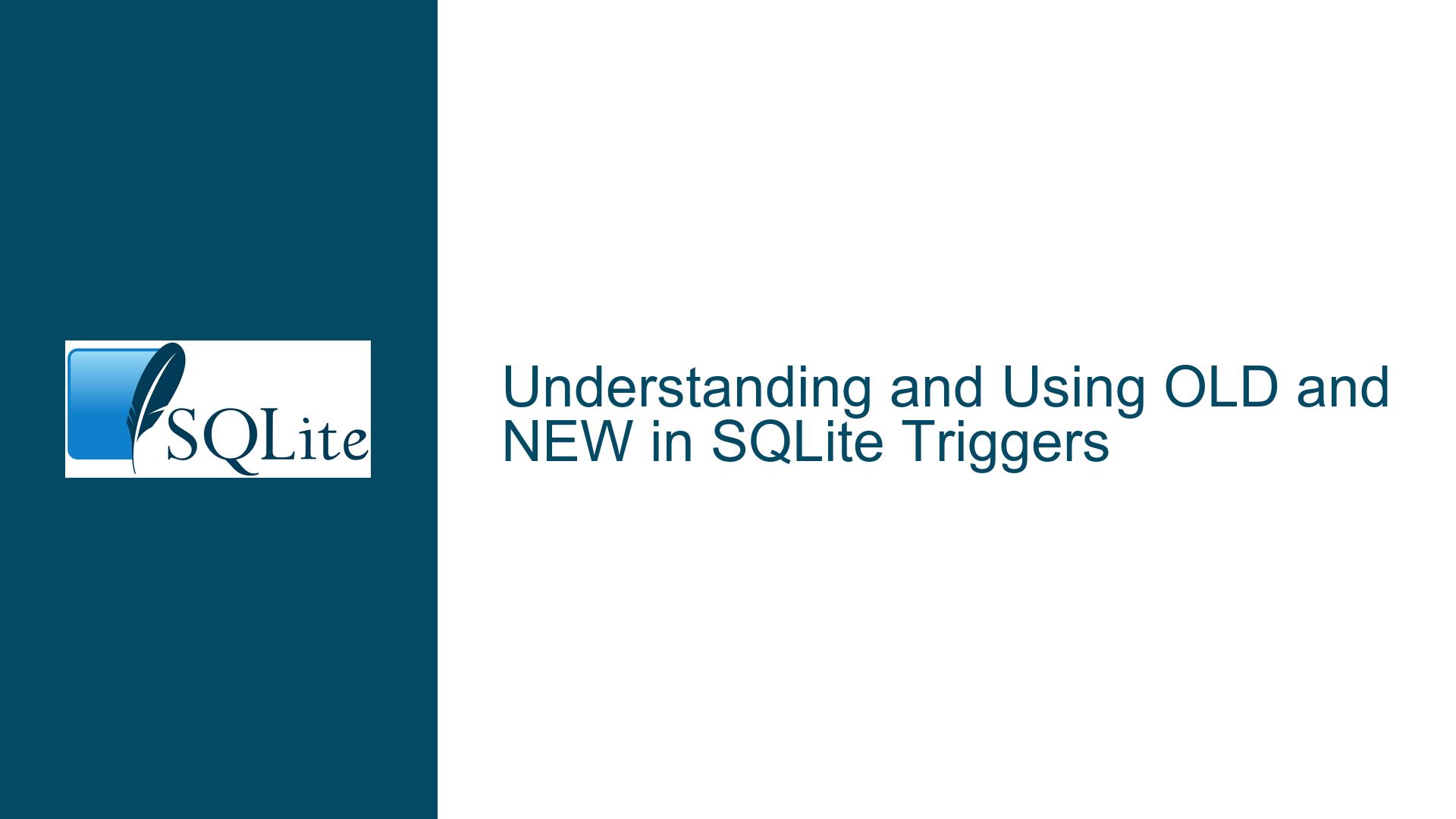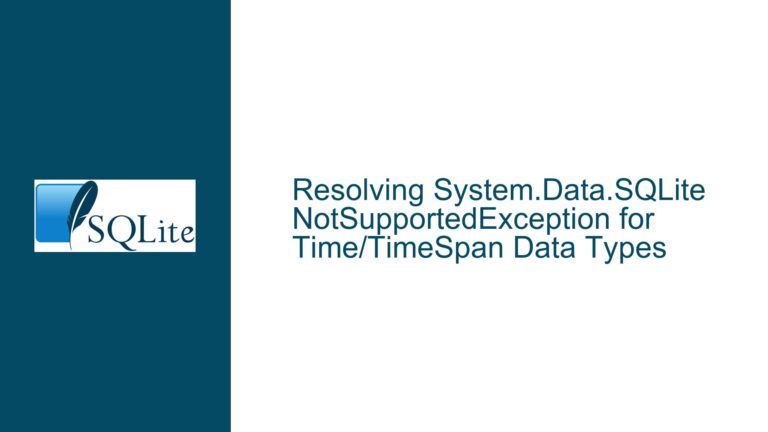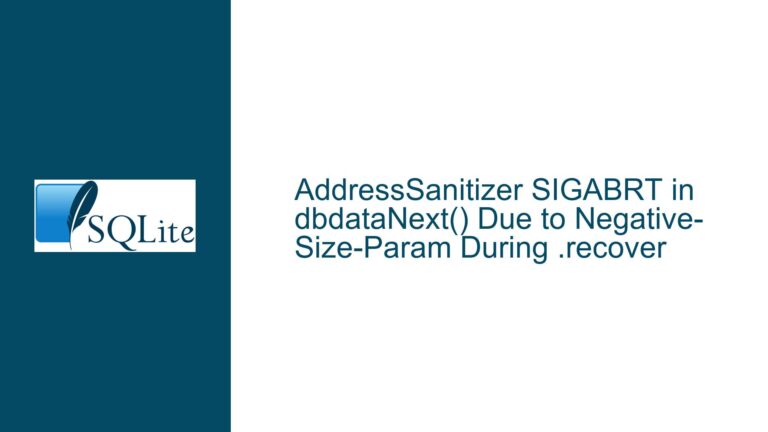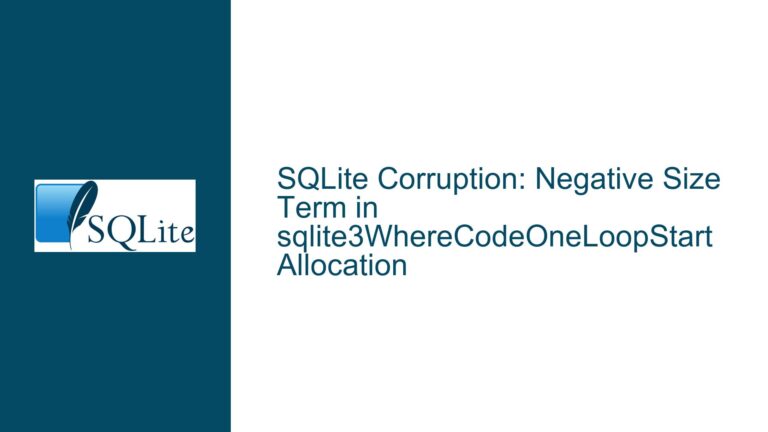and Using OLD and NEW in SQLite Triggers
Issue Overview: The Challenge of Generic OLD and NEW Usage in SQLite Triggers
In SQLite, triggers are powerful tools that allow developers to automate actions in response to specific database events such as INSERT, UPDATE, or DELETE operations. A common requirement when working with triggers is the need to access the state of a row before and after such operations. This is where the OLD and NEW keywords come into play. However, the discussion highlights a significant challenge: the inability to use OLD and NEW in a generic, dynamic manner. Specifically, the issue arises when attempting to create a trigger that can handle changes across multiple tables without hardcoding column names or types.
The core of the problem lies in the fact that OLD and NEW are not traditional columns or variables but rather references to the state of a row before and after a trigger event. This distinction is crucial because it affects how developers can interact with these references. For instance, while it is straightforward to access specific columns using OLD.column_name or NEW.column_name, there is no built-in mechanism to iterate over all columns in a row or to dynamically generate JSON patches or other complex structures based on the row’s state.
This limitation becomes particularly apparent when attempting to create a logging mechanism that records changes to a table in a generic way. The initial approach in the discussion involves using a function like create_json_patch(old, new) to generate a JSON representation of the changes. However, this approach fails because OLD and NEW cannot be passed directly as arguments to such functions. The error [ERROR] no such column: old underscores this limitation, as SQLite does not recognize OLD and NEW as standalone entities that can be manipulated or passed around like regular columns or variables.
Possible Causes: Why OLD and NEW Cannot Be Used Generically
The inability to use OLD and NEW in a generic manner stems from several fundamental aspects of SQLite’s design and the nature of triggers themselves. First, OLD and NEW are not first-class objects in SQLite. They are syntactic constructs that allow access to the state of a row before and after a trigger event, but they do not have a direct representation in SQLite’s type system. This means that while you can reference specific columns using OLD.column_name or NEW.column_name, you cannot treat OLD or NEW as a whole entity that can be passed to functions or iterated over.
Second, SQLite’s trigger mechanism is designed to be row-based, meaning that triggers fire once for each row affected by an operation. This design choice simplifies the implementation of triggers but also imposes limitations on how OLD and NEW can be used. Since triggers operate on a per-row basis, there is no built-in support for handling multiple rows or for performing operations that require knowledge of the entire table’s schema.
Third, SQLite’s extension mechanism, which allows developers to define custom functions, does not provide a way to handle complex structures like OLD and NEW. Custom functions in SQLite are typically defined to operate on individual values (e.g., sqlite3_value), and there is no straightforward way to pass an entire row or a set of columns to such functions. This limitation makes it difficult to create generic functions that can process OLD and NEW in a dynamic way.
Finally, the lack of documentation on the internal structure of OLD and NEW adds to the confusion. While the SQLite documentation explains how to use OLD and NEW to access specific columns, it does not provide detailed information on their underlying implementation or how they interact with SQLite’s type system. This lack of clarity can lead to misunderstandings and incorrect assumptions about what is possible with OLD and NEW.
Troubleshooting Steps, Solutions & Fixes: Working Around the Limitations of OLD and NEW
Given the limitations of OLD and NEW in SQLite, developers need to adopt alternative strategies to achieve generic functionality in triggers. Below are several approaches that can be used to work around these limitations, each with its own trade-offs and considerations.
1. Using PRAGMA table_info to Retrieve Table Schema
One approach to achieving generic functionality is to use the PRAGMA table_info command to retrieve the schema of the table associated with the trigger. This command returns information about each column in the table, including its name, type, and other attributes. By dynamically generating SQL code based on this information, it is possible to create triggers that can handle changes to any table without hardcoding column names.
For example, consider the following steps to create a generic logging trigger:
- Retrieve Table Schema: Use
PRAGMA table_info(table_name)to get a list of columns in the table. - Generate SQL Code: Construct an SQL statement that references each column using
OLD.column_nameandNEW.column_name. - Create Trigger: Use the generated SQL code to create a trigger that logs changes to the table.
Here is an example of how this might be implemented in Python using the sqlite3 module:
import sqlite3
def create_logging_trigger(conn, table_name):
cursor = conn.cursor()
cursor.execute(f"PRAGMA table_info({table_name})")
columns = [row[1] for row in cursor.fetchall()]
old_values = ", ".join([f"OLD.{col}" for col in columns])
new_values = ", ".join([f"NEW.{col}" for col in columns])
trigger_sql = f"""
CREATE TRIGGER IF NOT EXISTS log_all_changes AFTER UPDATE ON {table_name}
BEGIN
INSERT INTO logs (table_name, old_values, new_values)
VALUES ('{table_name}', json_object({old_values}), json_object({new_values}));
END;
"""
cursor.execute(trigger_sql)
conn.commit()
# Example usage
conn = sqlite3.connect('example.db')
create_logging_trigger(conn, 'users')
This approach allows for the creation of a generic logging trigger that can be applied to any table. However, it requires additional logic to handle different data types and to ensure that the generated SQL code is valid.
2. Generating SQL Code for Each Table
Another approach is to generate SQL code for each table that declaratively defines functions with the name and reference of each column. This approach involves creating a set of SQL statements that explicitly reference each column in the table, allowing for more control over how OLD and NEW are used.
For example, consider the following steps to create a generic JSON patch function:
- Retrieve Table Schema: Use
PRAGMA table_info(table_name)to get a list of columns in the table. - Generate JSON Objects: Construct JSON objects for
OLDandNEWusing thejson_objectfunction. - Create Trigger: Use the generated JSON objects to create a trigger that logs changes to the table.
Here is an example of how this might be implemented in SQL:
-- Retrieve table schema
PRAGMA table_info(users);
-- Generate JSON objects for OLD and NEW
SELECT json_object(
'id', OLD.id,
'first_name', OLD.first_name,
'last_name', OLD.last_name,
-- Add more columns as needed
) AS old_json,
json_object(
'id', NEW.id,
'first_name', NEW.first_name,
'last_name', NEW.last_name,
-- Add more columns as needed
) AS new_json
FROM users;
-- Create trigger
CREATE TRIGGER IF NOT EXISTS log_all_changes AFTER UPDATE ON users
BEGIN
INSERT INTO logs (table_name, json_patch)
VALUES ('users',
json_patch(
json_object(
'id', OLD.id,
'first_name', OLD.first_name,
'last_name', OLD.last_name
-- Add more columns as needed
),
json_object(
'id', NEW.id,
'first_name', NEW.first_name,
'last_name', NEW.last_name
-- Add more columns as needed
)
)
);
END;
This approach provides more flexibility in how OLD and NEW are used, but it requires manual intervention to generate the SQL code for each table. Additionally, it may not be suitable for tables with a large number of columns or for situations where the table schema changes frequently.
3. Using Custom Functions to Handle Complex Structures
A more advanced approach is to create custom functions that can handle complex structures like OLD and NEW. This approach involves defining a custom SQL function that takes multiple arguments (one for each column in the table) and returns a JSON object or other complex structure.
For example, consider the following steps to create a custom JSON patch function:
- Define Custom Function: Create a custom function that takes multiple arguments and returns a JSON object.
- Generate SQL Code: Construct an SQL statement that calls the custom function with the appropriate arguments.
- Create Trigger: Use the generated SQL code to create a trigger that logs changes to the table.
Here is an example of how this might be implemented in Python using the sqlite3 module:
import sqlite3
import json
def create_json_patch(*args):
old_values = args[:len(args)//2]
new_values = args[len(args)//2:]
patch = {}
for i, (old, new) in enumerate(zip(old_values, new_values)):
if old != new:
patch[f"column_{i}"] = {"old": old, "new": new}
return json.dumps(patch)
def create_logging_trigger(conn, table_name):
cursor = conn.cursor()
cursor.execute(f"PRAGMA table_info({table_name})")
columns = [row[1] for row in cursor.fetchall()]
old_args = ", ".join([f"OLD.{col}" for col in columns])
new_args = ", ".join([f"NEW.{col}" for col in columns])
trigger_sql = f"""
CREATE TRIGGER IF NOT EXISTS log_all_changes AFTER UPDATE ON {table_name}
BEGIN
INSERT INTO logs (table_name, json_patch)
VALUES ('{table_name}', create_json_patch({old_args}, {new_args}));
END;
"""
cursor.execute(trigger_sql)
conn.commit()
# Example usage
conn = sqlite3.connect('example.db')
conn.create_function('create_json_patch', -1, create_json_patch)
create_logging_trigger(conn, 'users')
This approach allows for the creation of a custom function that can handle complex structures, but it requires additional logic to define the function and to ensure that it is called correctly in the trigger. Additionally, it may not be suitable for all use cases, particularly those that require more advanced functionality.
4. Combining Approaches for Maximum Flexibility
In many cases, the best solution is to combine the above approaches to achieve maximum flexibility. For example, you could use PRAGMA table_info to retrieve the table schema and then generate SQL code that calls a custom function to handle complex structures. This approach allows you to leverage the strengths of each method while minimizing their weaknesses.
Here is an example of how this might be implemented:
import sqlite3
import json
def create_json_patch(*args):
old_values = args[:len(args)//2]
new_values = args[len(args)//2:]
patch = {}
for i, (old, new) in enumerate(zip(old_values, new_values)):
if old != new:
patch[f"column_{i}"] = {"old": old, "new": new}
return json.dumps(patch)
def create_logging_trigger(conn, table_name):
cursor = conn.cursor()
cursor.execute(f"PRAGMA table_info({table_name})")
columns = [row[1] for row in cursor.fetchall()]
old_args = ", ".join([f"OLD.{col}" for col in columns])
new_args = ", ".join([f"NEW.{col}" for col in columns])
trigger_sql = f"""
CREATE TRIGGER IF NOT EXISTS log_all_changes AFTER UPDATE ON {table_name}
BEGIN
INSERT INTO logs (table_name, json_patch)
VALUES ('{table_name}', create_json_patch({old_args}, {new_args}));
END;
"""
cursor.execute(trigger_sql)
conn.commit()
# Example usage
conn = sqlite3.connect('example.db')
conn.create_function('create_json_patch', -1, create_json_patch)
create_logging_trigger(conn, 'users')
This combined approach provides the flexibility to handle complex structures while also allowing for dynamic generation of SQL code based on the table schema. It is particularly useful in situations where the table schema may change frequently or where the logging requirements are complex.
Conclusion
While SQLite’s OLD and NEW keywords provide a powerful way to access the state of a row before and after a trigger event, their use is limited by the fact that they are not first-class objects and cannot be used in a generic, dynamic manner. However, by leveraging techniques such as PRAGMA table_info, dynamic SQL generation, and custom functions, developers can work around these limitations and create triggers that are both flexible and powerful. Each approach has its own trade-offs, and the best solution will depend on the specific requirements of the application. By understanding the underlying limitations and exploring alternative strategies, developers can unlock the full potential of SQLite triggers and create robust, maintainable database solutions.






